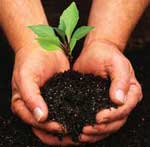In lieu of a dedicated topic, this edition of tree tips will be a collection of some of the most common tree questions that have been asked of both Master Gardeners and extension staff.
1. When is the best time to plant a tree? – As the weather gets cooler it becomes the perfect time to plant trees. The cooler weather puts less pressure on the tree while it is establishing its root system. When planting new trees, it is important to plant the tree with the rootball an inch or two above the soil surface. A good saying that can help you remember this is "plant it high and it won't die" (thanks Mike Robinson). Also, most trees growing in containers will have roots that grow in a circular pattern where the roots came in contact with the container. These circling roots need to be cut at the point where they came in contact with the container. This way the new roots will grow out into the landscape soil.
2. I have a lacebark elm tree in my yard and I am noticing a lot of twigs and leaves all over the yard. What is causing this? – This is always a common question this time of year. The anwer is that it is squirrels causing the mess. As they break off small twigs to get to the seeds, they drop many more than they eat. Not only is this common on lacebark elm (Drake), it is common on all sorts of trees that produce seeds this time of year such as oaks, and cedars.
3. My citrus fruit are rough feeling and have this black and bronze color to it. What can I do? – The signs of citrus rust mite are showing up now although the damage occurred a few months ago. Citrus rust mites are tiny. As they feed on the rind of citrus their raspy mouth parts damage the outside of the fruit causing it to be discolored. The good news is that the fruit is fine to eat. Unfortunately the time to treat citrus rust mite is in the early summer. Softer pesticides like horticultural oils, and insecticidal soaps work well. These products can scorch the leaves when used during the heat of the day so make sure you read and follow label directions when mixing and applying pesticides.
4. Do I need to fertilize the trees in my yard? – Unless you have fruit trees, or palms that need more nutrients to produce abundantly, the answer is generally No. Most established trees do not need any additional nutrition. The key to this is to plant the right tree in the right place. If your tree is not growing properly, don't immediately think about adding fertilizer. There are all sorts of other reasons for poor tree growth. Check for disease, circling roots, planting depth, mulch volcano's and the soil pH. Sometimes adding fertilizer can make things worse by forcing the tree to put energy into growing foilage when it needs to be conserving energy to fight off disease. Yellowing leaves can indicate an iron deficiency caused when the soil pH is too high. Usually adjusting the pH fixes the problem.
|





